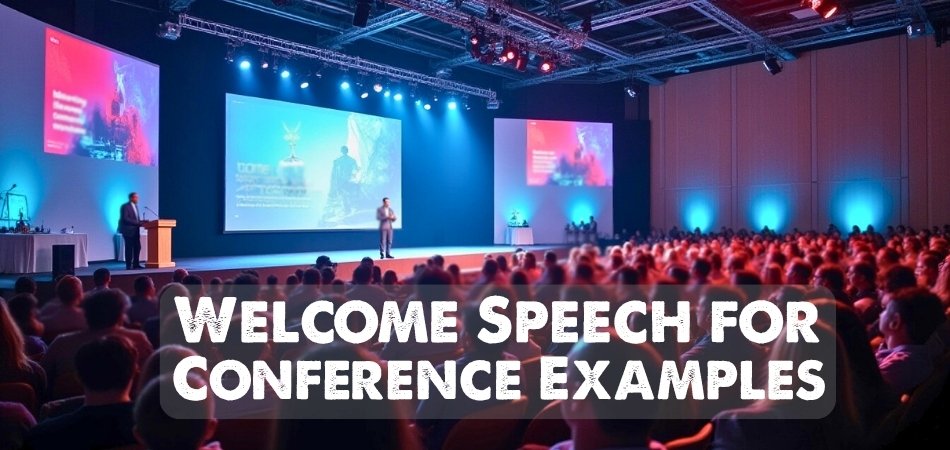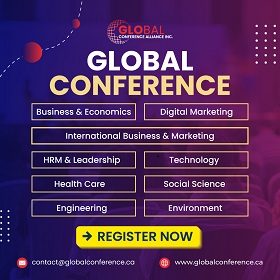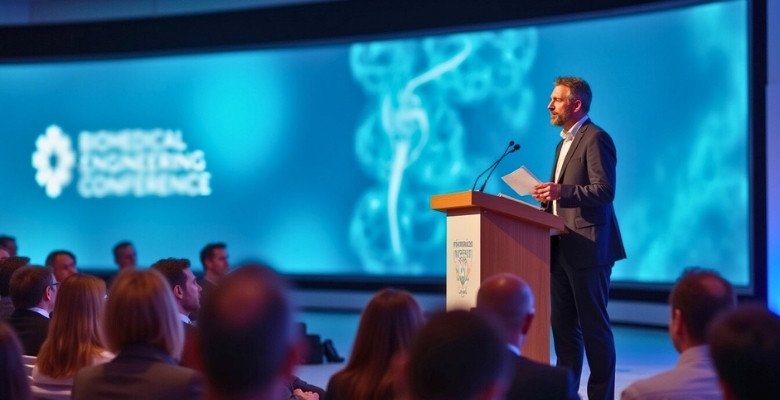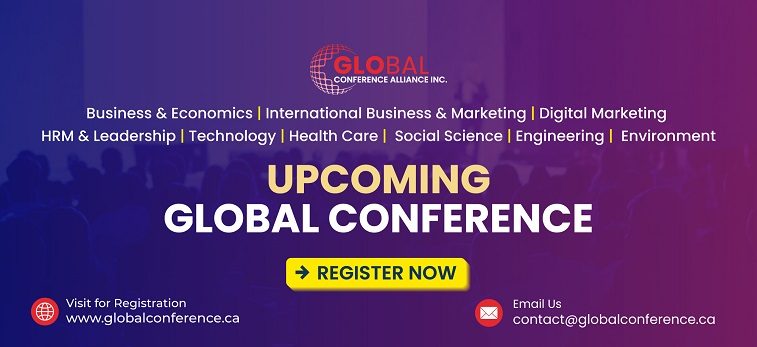When planning a conference, setting the right tone at the beginning can seem challenging. A dull or unorganized welcome speech can leave the audience disconnected and uninterested. That’s why it’s important to begin with clarity, warmth, and purpose.
The best way to ease that pressure is to use a welcome speech for conference examples that are already customized for different settings. A good welcome speech should strike a good balance between being formal and professional, inspirational and vision-driven, and friendly and warm. Preparing a speech that captures all these elements can be challenging, but not impossible.
The examples below are carefully written to fit every type of event and audience. If you are looking for inspiration or something ready to use, scroll down until you find the examples you need.
Welcome Speech for Conference Examples
Setting a meaningful and successful tone at the beginning of a conference is essential. It doesn’t matter if your audience consists of industry leaders, academic researchers, or enthusiastic students; a well-crafted welcome speech can energize, inspire, and connect them all. Listed below are 8 welcome speeches – each written in a distinctive tone to suit different themes and situations.
1. Formal and Professional
Good morning, distinguished guests, respected colleagues, and honored speakers,
It is with great pride and privilege that I welcome you to the 2025 Global Healthcare Conference. Your presence signifies a shared dedication to progress, innovation, and excellence in our field.
Over the next few days, we will engage in meaningful discussions, learn from cutting-edge research, and build connections that will drive healthcare forward.
Thank you for being here. Let’s work together to make this event impactful and productive.
2. Warm and Friendly
Hello everyone,
Welcome to our annual conference! It’s so wonderful to see familiar faces and new ones joining us this year. This isn’t just a time to attend sessions—it’s a time to share stories, discover new perspectives, and grow together.
Whether you’re a speaker, a first-time attendee, or a longtime participant, we’re so glad you’re here.
Enjoy the sessions, take time to connect, and let’s make this conference memorable for all the right reasons.
3. Student-Friendly and Inclusive
Hi and welcome,
It’s truly exciting to see such a vibrant mix of professionals, students, and educators here today. No matter where you are in your journey—whether just starting or well along your path—you belong here.
This conference is about learning from each other, supporting growth, and creating space for new voices and ideas. So don’t be shy—ask questions, join discussions, and be proud of the contributions you bring.
Let’s have a great start together!
4. Inspirational and Vision-Driven
Good morning, esteemed attendees,
Today, we gather not just as medical professionals, but as changemakers. Each of us holds a piece of the future of healthcare, and this conference is a chance to connect those pieces.
Let the ideas shared here inspire action. Let the breakthroughs challenge the status quo. And let our collective commitment ignite real-world change.
Thank you for your dedication. Let’s dream big and act boldly—starting now.
5. Peer-Focused and Collaborative
Good day, colleagues,
It’s a pleasure to welcome you to this year’s conference. Among us are clinicians, researchers, educators, and innovators—all peers who understand the challenges and rewards of our work.
This is a space for open dialogue, shared experiences, and real collaboration. We’re here to learn from each other—not just as professionals, but as partners.
Thank you for your openness and your time. Let’s make these days count together.
6. Casual and Uplifting
Hey everyone,
So great to see you all here today! Whether you traveled from far away or just down the street, we’re thrilled to have you join us.
We’ve got some incredible sessions, thought-provoking panels, and fun networking ahead. So settle in, say hi to someone new, and get ready for a few days of learning, laughter, and maybe even a little inspiration.
Let’s make this a conference to remember—welcome!
7. Future-Focused and Practical
Good morning to all,
Welcome to a conference designed to prepare us for the future of medicine. We are in a time of rapid evolution—technologies, patient expectations, and global health systems are shifting fast.
Here, we’ll explore what’s next and how we can lead the change with evidence, compassion, and innovation.
Let’s challenge ourselves to think differently and act wisely. I look forward to the insights you’ll all bring.
8. Reflective and Gratitude-Based
Hello and welcome,
As we open this year’s conference, I want to begin with gratitude—gratitude for your presence, your time, and the work you do each day in advancing health and healing.
This event is a celebration of knowledge, but also a reminder of the shared values that bring us together: service, curiosity, and compassion.
Let’s carry those values into every session and every conversation over the next few days. Thank you for being here, and let’s make the most of this opportunity.
Why Does the Opening Speech Matter in Conferences?
People usually hear the opening speech when a conference begins. It might sound simple, but this short moment plays a big role in the event. It sets the mood, grabs attention, and shows people what to expect. Here are some reasons why it matters:
Sets the Right Mood
The opening speech helps everyone feel ready and focused. It gives a sense of importance to the event and makes people want to listen. A calm, happy tone can make the audience feel relaxed. If it’s too serious or boring, people might lose interest early. That’s why getting the tone right is important.
Makes Everyone Feel Welcome
When the host says “welcome,” it makes people feel seen and included. A good speech mentions the audience, like guests or speakers, and shows that their presence matters. This helps create a friendly and open space. People feel more comfortable when they know they’re being appreciated. That’s a great way to start any event.
Gives the Big Picture
The opening speech tells people what the event is about. It talks about the main topic and what the event hopes to achieve. This helps people understand why they’re there. Without this part, some may feel lost or unsure about what’s going on. A simple overview can make everything clearer.
Builds Excitement
A strong opening speech can get people excited about what’s coming next. It can talk about interesting speakers, fun sessions, or important topics. When people hear about what’s planned, they feel more interested and ready to join in. It’s like giving a sneak peek of the good stuff ahead.
Shows Respect
Saying a few kind words at the beginning shows respect to the people who joined. It tells them their time matters and they’re part of something important. Thanking guests, speakers, or sponsors in the speech is also a good habit. It makes people feel valued. This simple act can build a positive vibe.
Helps People Focus
Sometimes people come into a room still thinking about other things. A clear and steady opening speech can help them stop and pay attention. It brings their mind into the moment. With everyone focused, the event can move forward smoothly. That’s a big win for both the host and the crowd.
Starts the Event Strong
First impressions last, and the opening speech is often the first real moment of the event. A strong start shows the event is well-planned and worth their time. It gives people a good feeling about what’s coming. Even a short speech can leave a lasting effect. That’s why it matters so much.
Best Way to Structure a Welcome Speech For a Conference
Every great event needs a good start, and the welcome speech is where it all begins. A well-structured speech can make people feel ready, focused, and excited. But just talking isn’t enough—it needs the right flow. Let’s look at how to build a strong and simple welcome speech that works well for any event.
Start with a Greeting
Always begin by saying hello to your audience. You can greet everyone together or mention special guests if there are any. A warm greeting helps people feel noticed and included. Keep it simple and friendly. This small step makes a big difference.
Say Thank You
After greeting, take a moment to thank the audience for coming. You can also thank any speakers, helpers, or sponsors. People feel good when their time and effort are appreciated. A short thank you can create a positive feeling. It sets a nice tone for the rest of the speech.
Talk About the Event
Now it’s time to say what the event is about. Give a short and clear idea of the main topic or goal. You can also give an example, like mentioning upcoming conferences in Canada that focus on similar themes. This helps people understand why the event is happening. Keep it short—just the basic idea is enough. Too many details might confuse people early on.
Mention What to Expect
Tell the audience what will happen during the event. You can name speakers, topics, or fun parts to look forward to. This helps everyone feel more prepared and interested. People like knowing what’s coming. Just give a quick preview, not the full schedule.
Add a Personal Note
It’s nice to include a short personal line or story. This could be why the event matters to you or something you’re excited about. It makes your speech feel real and friendly. People like hearing something honest. Keep it short and simple.
Keep It Short
A welcome speech should never be too long. Try to keep it under three to four minutes. If it drags, people lose interest before the event even starts. Just say the important things and move on. Short, clear words are always better.
End on a High Note
End your speech with a positive line. You could wish everyone a great time or say you’re excited to get started. The last line should leave people feeling good. A strong finish helps the event begin with energy. Smile and speak with confidence.
How to Improvise a Short Welcome if You’re Unprepared?
Sometimes, things don’t go as planned. You might be asked to give a welcome speech at the last minute with no time to prepare. It can feel difficult, but it’s not impossible. Here is how to handle the moment with calm and confidence.
Take a Deep Breath
The first thing to do is stop and take a deep breath. This helps you feel calmer and in control. When you feel nervous, your mind can get confused. A short pause helps your thoughts come together. It also gives your body time to relax. Just breathing slowly can help more than you think.
Start with a Smile
Smiling is a great way to start. It makes people feel comfortable and shows you’re friendly. When you smile, it also helps you feel a little more relaxed inside. Even if you’re nervous, a smile makes it easier to talk. The audience will feel that good energy. A smile is a simple but powerful tool.
Keep It Simple
You don’t have to say anything big or fancy. Just use clear and easy words, like you’re talking to a friend. Say hello, welcome everyone, and share one small thought about the event. If you ever need to give a quick welcome speech for conference, short and simple words work best. There’s no need to be perfect. People will like it more if you speak from the heart.
Say What Matters
Think quickly about what the event is about. Say one or two lines that connect to that purpose. For example, if it’s a health event, say you’re glad people are here to talk about health. That shows you understand the reason for the event. It helps people know they’re in the right place. Even a short message makes a big impact.
Thank the Audience
Always take a moment to say thank you. You can thank everyone for showing up, or thank the people who worked hard to plan the event. It shows respect and good manners. People feel happy when they are appreciated. A simple “thank you for being here” is enough. It leaves a good feeling in the room.
End with Positivity
Finish with something nice and cheerful. You can say, “Let’s have a great time,” or “We’re looking forward to a good day.” Try to end with a smile as well. Your last line should leave the audience feeling good. Don’t worry about being fancy—just be kind and clear. Then step away with calm and confidence.
How Long Should Your Welcome Speech Be?
A welcome speech doesn’t need to be long to be good. In fact, the shorter and clearer it is, the better your audience will stay focused. Here’s a simple table to help you decide the best length based on the type of event:
| Event Type | Ideal Speech Length | Why This Length Works |
| Small Meeting | 1–2 minutes | Keeps things light and moves the event forward quickly. |
| Workshop or Training | 2–3 minutes | Enough time to greet, explain the purpose, and set the tone. |
| School or Community Event | 3–4 minutes | Allows room for thanks, and a short message or story. |
| Formal Conference | 4–5 minutes | Good for welcoming guests and introducing key highlights. |
| Large Public Event | 5–6 minutes | Gives space to thank many people and build excitement. |
Tips for Making a Welcome Speech Engaging for Conference Attendees
A welcome speech is more than just saying hello. If it’s boring, people stop paying attention even before the event begins. But when it feels real and exciting, the crowd listens. Let’s look at some easy ways to make your welcome speech more fun and interesting.
Use a Light Tone
No one enjoys a speech that feels too stiff or serious. Try to sound cheerful and natural, like you’re having a friendly talk. A light tone helps people feel relaxed and ready to listen. It also shows that you enjoy being there. That feeling spreads to the audience.
Include a Fun Fact
Adding a surprising or fun fact can grab attention fast. It could be something about the topic or even the place where the event is being held. People like learning something new right away. It makes your speech stand out. Just make sure it fits the mood of the event.
Tell a Short Story
A short and simple story can make your speech more personal. You could share something funny or interesting that connects to the theme. Stories are easier to remember than facts. They also help people feel more connected to you. Just keep it short and on-topic.
Use a Question
You can ask the audience a quick question—not for them to answer, just to make them think. It wakes up their minds and keeps them interested. For example, “Have you ever wondered how one idea can change everything?” A question like this pulls people in. It makes them curious about what’s next.
Mention the Audience
Let the people know they matter. Say something kind about their role in the event. One of the important elements of a welcome speech is making sure the audience feels included and valued. For example, you could say, “This event wouldn’t be the same without you here.” This makes everyone feel included. When people feel seen, they listen more.
Add a Little Humor
A small joke or funny line can make everyone smile. It doesn’t need to be perfect—just something simple to lighten the mood. Laughter helps people feel more open and ready to enjoy the day. Be careful not to make fun of anyone, though. Kind and light humor always works best.
Frequently Asked Questions
When preparing to deliver a welcome speech, many questions can come to mind, especially if you’re unsure about what to say, how to say it, or how to keep people interested. This section answers the most common questions people ask when creating or giving a welcome speech for a conference.
How Can I Start a Welcome Speech Without Sounding Repetitive?
You can start your speech by sharing a warm greeting, followed by a unique sentence related to the event theme. Instead of always saying “It’s my pleasure to welcome you,” try something personal or specific to the day. This keeps the beginning fresh.
What Are Some Safe Opening Lines for Any Conference?
Safe opening lines include “Good morning, everyone. We’re happy to have you here,” or “It’s a pleasure to welcome such a great group today.” These lines are simple, polite, and work for both formal and informal settings without sounding too stiff.
How Do I Practice My Welcome Speech Effectively?
Practice by saying your speech out loud several times. Read it in front of a mirror or a friend. Try to speak slowly and clearly, and focus on natural pauses. The more you repeat it, the more confident you will feel when the real moment comes.
Can I Use Quotes in a Welcome Speech?
Yes, using a quote can add meaning to your speech. Just make sure it fits the theme and doesn’t sound forced. A short quote at the beginning or end can help set the tone or leave a strong impression on your audience.
What Should I Avoid Saying in a Welcome Speech?
Avoid using negative words, long stories, or anything unrelated to the event. Try not to make the speech about yourself. Keep it focused on the audience and the event. Stay positive and polite to keep the audience interested and respectful.
Should I Memorize My Speech Word for Word?
It’s not necessary to memorize every single word. It’s better to remember the key points and speak naturally around them. Memorizing can sometimes make you sound robotic, while speaking freely with notes keeps your voice more relaxed and real.
How Do I Add Energy Without Sounding Overexcited?
Use your voice in a friendly and upbeat way without shouting. Smile while you speak, use hand gestures if it feels natural, and speak with interest in your voice. This helps keep the mood energetic but not too loud or fake.
What If I Make a Mistake While Speaking?
It’s okay! Most people don’t even notice small mistakes. Just pause, take a breath, and continue. Don’t apologize or draw attention to it. Keep going confidently, and your audience will stay with you.
Conclusion
No matter who you are or what kind of event you’re hosting, a good welcome speech can truly set the stage. From breaking the ice to making everyone feel comfortable, those first words matter more than you might think. Choosing the right style makes all the difference.
If you need inspiration or feel unsure where to start, these welcome speech for conference examples are designed to help you find your voice. Whether you want to sound professional, warm, or even a little funny, you’ll find the perfect fit here.
So go ahead—try out a new idea or borrow a few lines. With the right words, your next event can begin with confidence, energy, and connection. Your audience will remember your welcome long after the conference is over.








